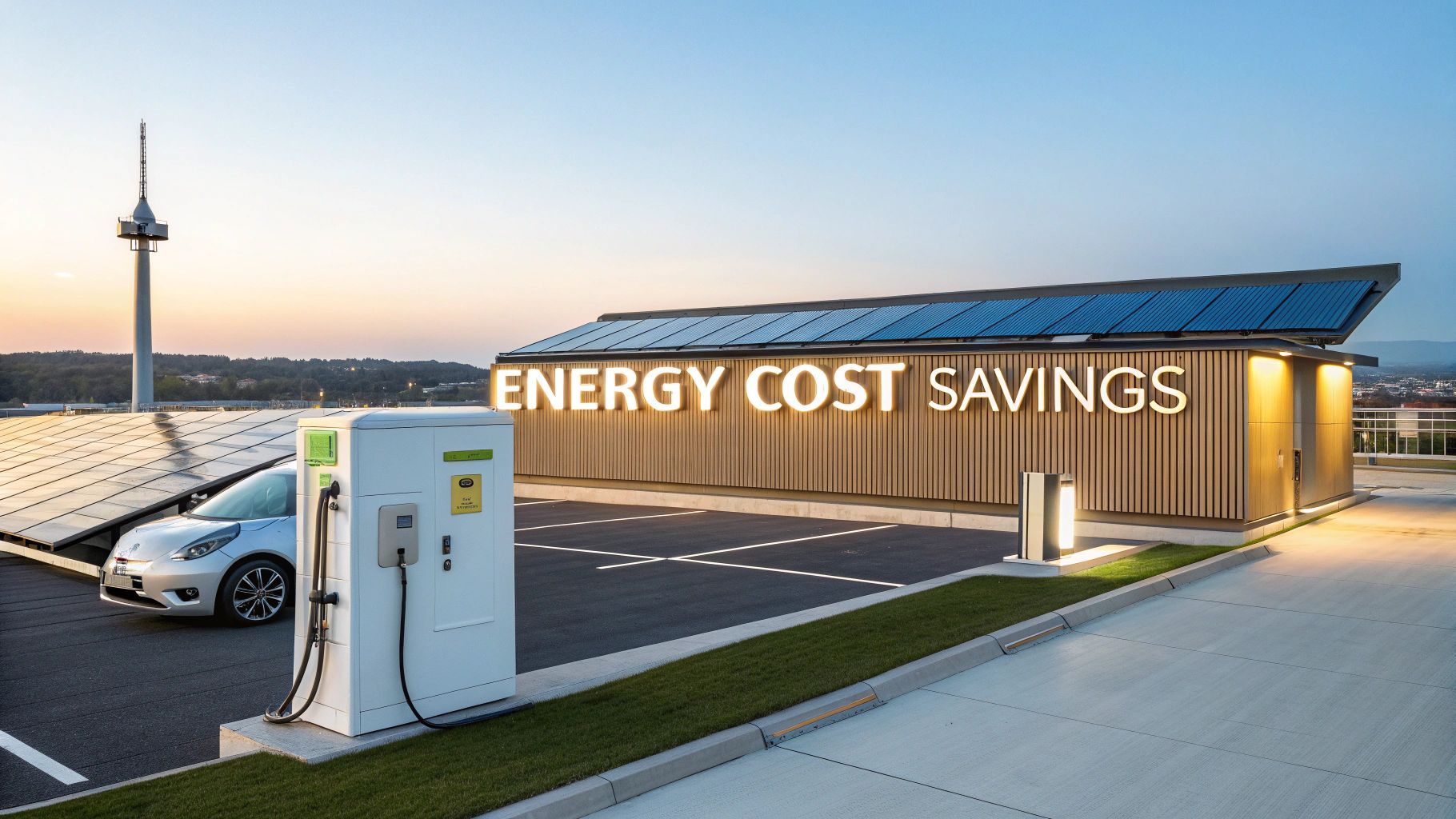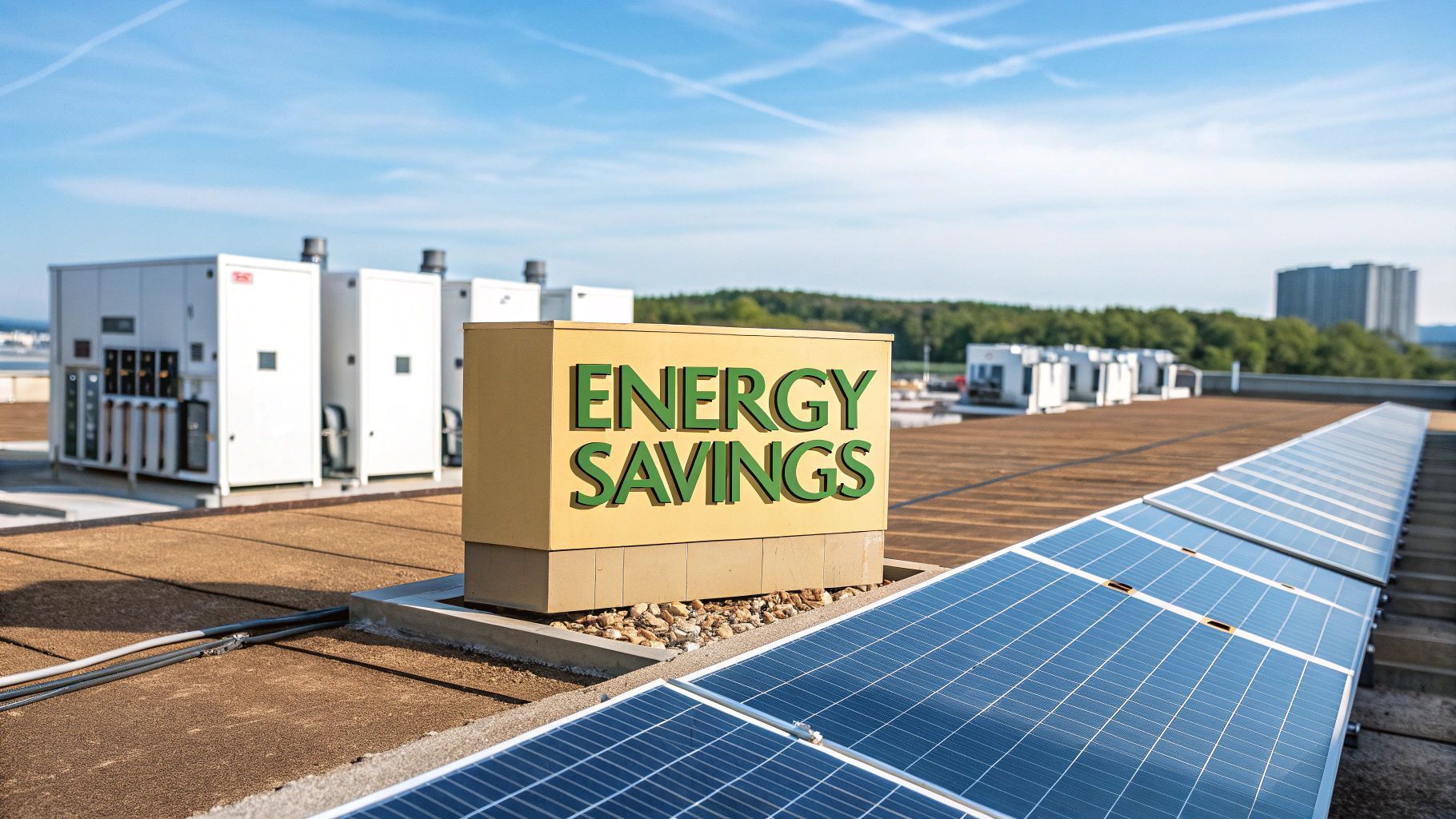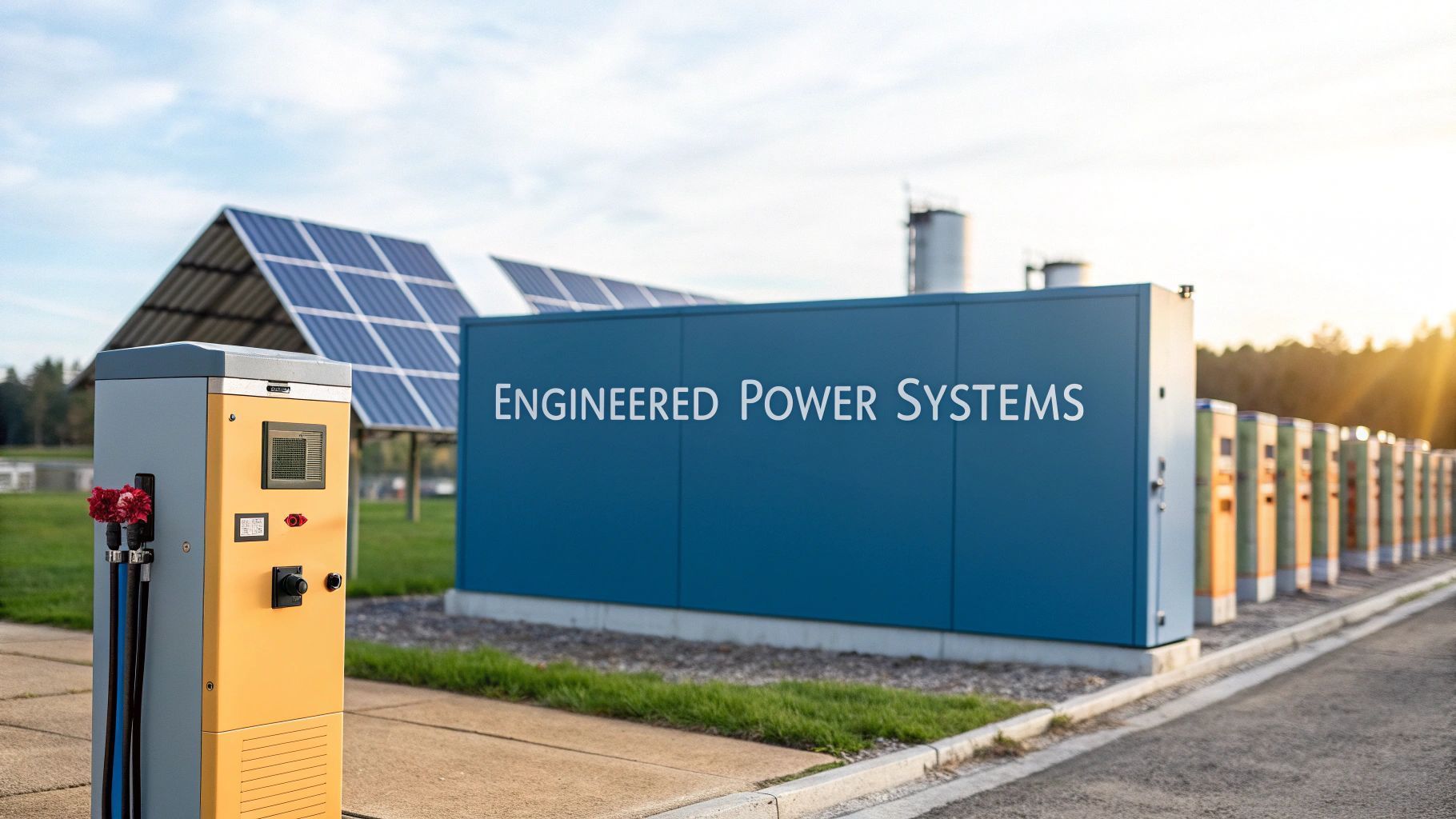UK Storage Battery Systems Powering the Future
Storage battery systems are the unsung heroes of our modern energy grid. Think of them like a financial savings account but for electricity. They store power when it is plentiful and cheap—like during windy nights—and then release it when demand spikes and costs are at their highest. This simple act of balancing makes them absolutely fundamental to the UK's energy security and our transition to a greener future.
The Critical Role of Storage Battery Systems in the UK
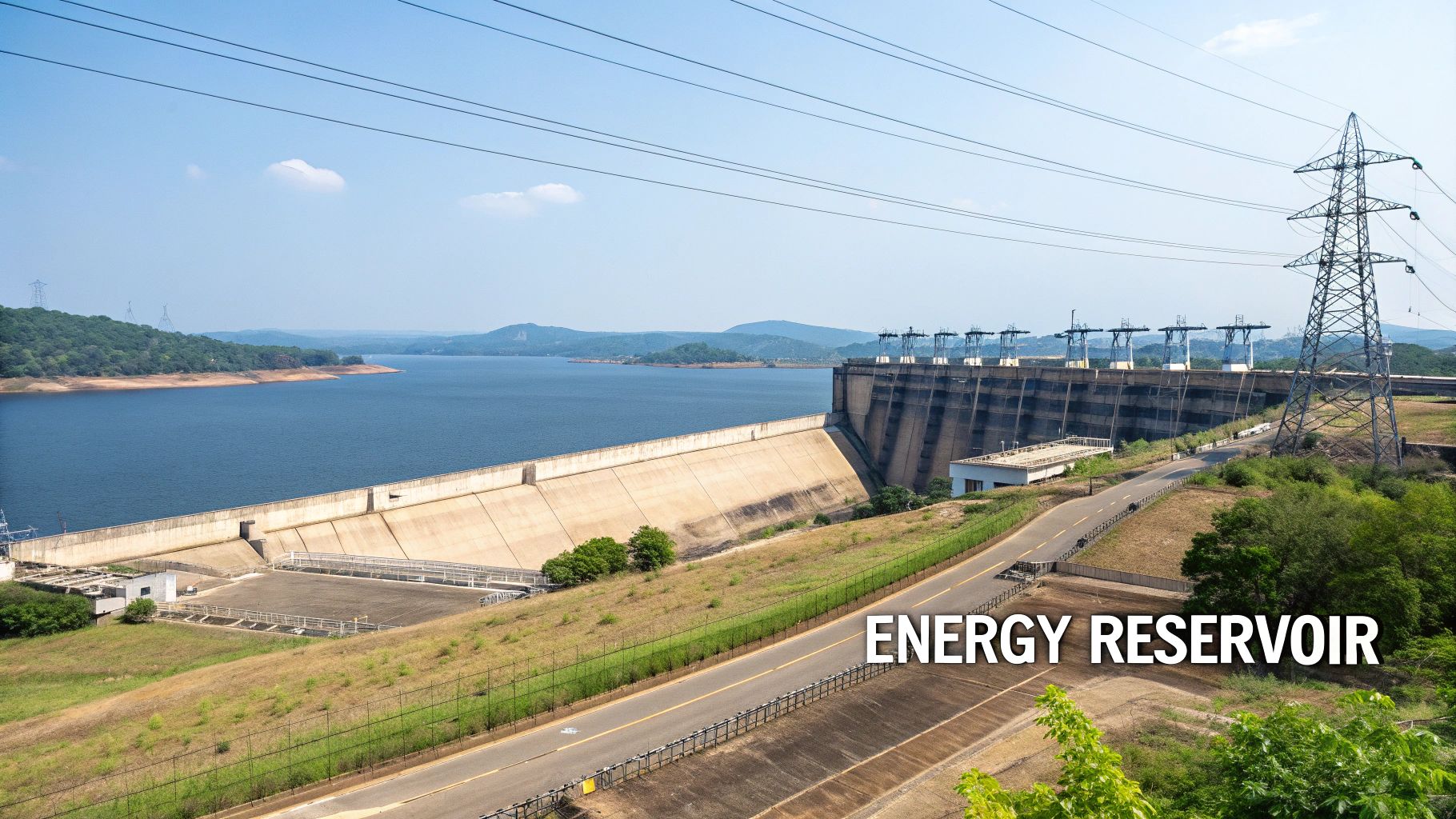
Imagine trying to fill a swimming pool with a garden hose during a drought. That is pretty much the challenge the UK's grid is facing with the explosive growth of renewable energy and electric vehicles (EVs). For decades we have relied on a simple model: generate electricity the very moment it is needed. But that way of thinking is fast becoming outdated.
Renewables like wind and solar are fantastic but they are intermittent. They generate power when the sun shines or the wind blows, not necessarily when we all decide to switch on our kettles. At the same time the huge demand for rapid EV charging creates intense, short bursts of power consumption that local grid infrastructure often cannot handle. These two forces are creating a major mismatch between supply and demand.
Solving the Modern Energy Puzzle
This is exactly where storage battery systems come in. They are far more than just big power banks; they act as intelligent buffers, soaking up excess energy and injecting it back into the grid with surgical precision right when it is needed most.
These systems are now indispensable for a whole range of critical applications across Britain:
- Enabling Rapid EV Charging: They make it possible to install powerful charging hubs in grid-constrained areas. The system simply stores up energy during off-peak hours and then unleashes it to charge multiple vehicles at once during the day.
- Supporting On-site Renewables: Businesses with solar panels can capture all that surplus energy generated on a sunny afternoon and use it later, squeezing every drop of value from their investment and cutting their reliance on the grid.
- Strengthening Grid Stability: At a national level, grid-scale batteries respond in milliseconds to fluctuations, preventing outages and guaranteeing a stable power supply for millions of homes and businesses.
A Foundation for Distributed Energy
The rollout of storage battery systems is laying the groundwork for a much smarter and more resilient network of distributed energy resources . Instead of depending on a handful of massive power stations, the grid of the future will be a web of thousands of smaller assets, from commercial batteries to mobile EV charging units.
A robust battery storage infrastructure is no longer a luxury—it is a necessity. It is the key that unlocks the full potential of renewable energy and supports the widespread electrification of transport, making our energy system cleaner, more flexible and more secure.
This technology directly confronts the biggest hurdles of our energy transition. By providing a reliable way to store and deploy clean energy, storage battery systems are empowering businesses, supporting grid operators and speeding up the UK’s journey towards a sustainable future.
How a Storage Battery System Actually Works
A Battery Energy Storage System (BESS) might sound complicated but once you look under the bonnet the principles are quite straightforward. At its heart, a BESS is just a clever team of components working in perfect harmony to store electrical energy and release it exactly when needed.
Let’s pull it apart without getting bogged down in technical jargon. A modern BESS really comes down to three core parts, each with a critical job to do. Getting your head around how they work together is the key to understanding just how powerful storage battery systems can be, whether they are powering a rapid EV charger or stabilising the national grid.
This diagram gives a great overview of the fundamental parts inside a typical system.
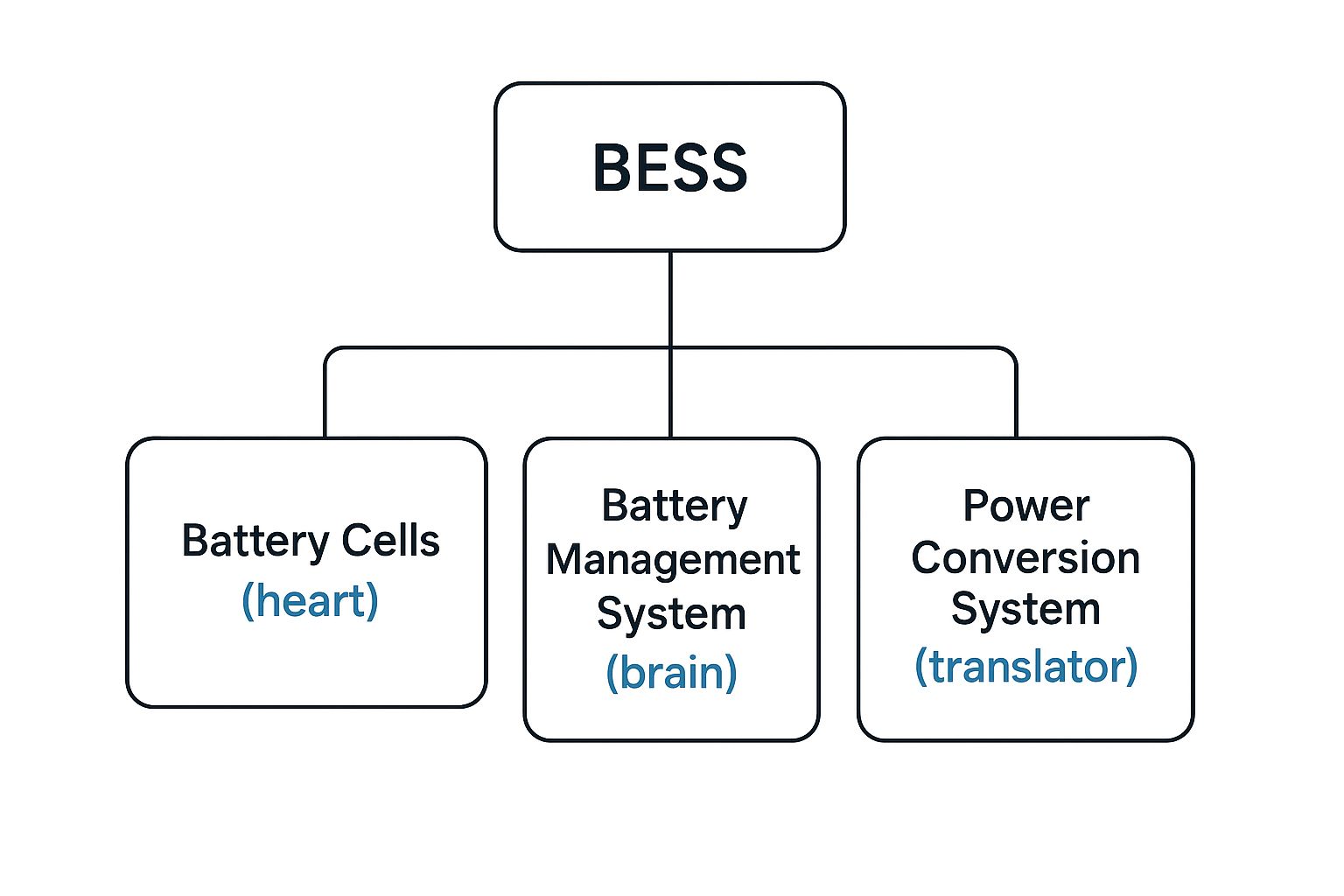
As you can see, it's a trio of cooperating elements: the cells that hold the energy, the management system that keeps everything in check and the conversion system that makes the power usable.
To really get to grips with what’s going on, it helps to think of a BESS as having a heart, a brain and a translator.
The Heart: The Battery Cells
The foundation of any BESS is the battery cells . These are the physical units where electrical energy is stored as chemical potential. Think of them as the heart of the system—the reservoir holding all that power until it gets the call to action.
Most of today's storage battery systems are built with lithium-ion cells, which are popular for their excellent energy density and long lifespan. You do not just use one or two, though. Thousands of these individual cells are grouped into modules, which are then assembled into bigger packs or racks. This modular approach allows a BESS to be scaled up to meet almost any demand, from a small unit for a mobile EV charger to a massive, warehouse-sized installation supporting the grid.
The Brain: The Battery Management System
Watching over the heart is the brain of the whole operation: the Battery Management System (BMS) . This smart control unit is the real unsung hero, constantly monitoring the health and performance of every single cell to make sure the entire system runs safely and at peak efficiency.
The BMS handles several crucial jobs:
- Protecting the Cells: It acts like a guardian, preventing overcharging or discharging too deeply, both of which can damage the batteries and slash their lifespan.
- Balancing Performance: It ensures every cell charges and discharges at a similar rate, which is vital for maximising the system's total capacity and making it last longer.
- Managing Temperature: The BMS is the thermostat, using cooling or heating to keep the batteries in their ideal temperature zone for optimal performance.
- Communicating Data: It feeds back vital stats like the state of charge and overall system health to the main energy management software, giving operators a clear view of what’s happening.
Frankly, without a solid BMS even the best battery cells would be unreliable and unsafe. It is this intelligent oversight that makes the system dependable enough for demanding jobs like rapid EV charging or backing up local energy networks.
The Translator: The Power Conversion System
Finally, you have the 'universal translator', officially known as the Power Conversion System (PCS) . Batteries store energy as Direct Current (DC) but pretty much everything else—from our homes and businesses to the national grid—runs on Alternating Current (AC). The PCS is the essential bridge between these two electrical worlds.
The Power Conversion System is like a currency exchange for electricity. It expertly converts the stored DC power from the batteries into the usable AC power that our appliances and the grid need. It also works in reverse, turning AC from the grid back into DC to charge the batteries.
This two-way capability is what makes a BESS so incredibly flexible. It can flip from charging (taking in power) to discharging (sending power out) in milliseconds. This lightning-fast response is what allows it to stabilise grid frequency or deliver the huge, instant burst of power needed to charge an electric vehicle. For any situation involving EV charging from a constrained grid connection or using on-site renewables, the PCS is the component that makes it all work.
Solving the EV Charging Challenge on Constrained Grids
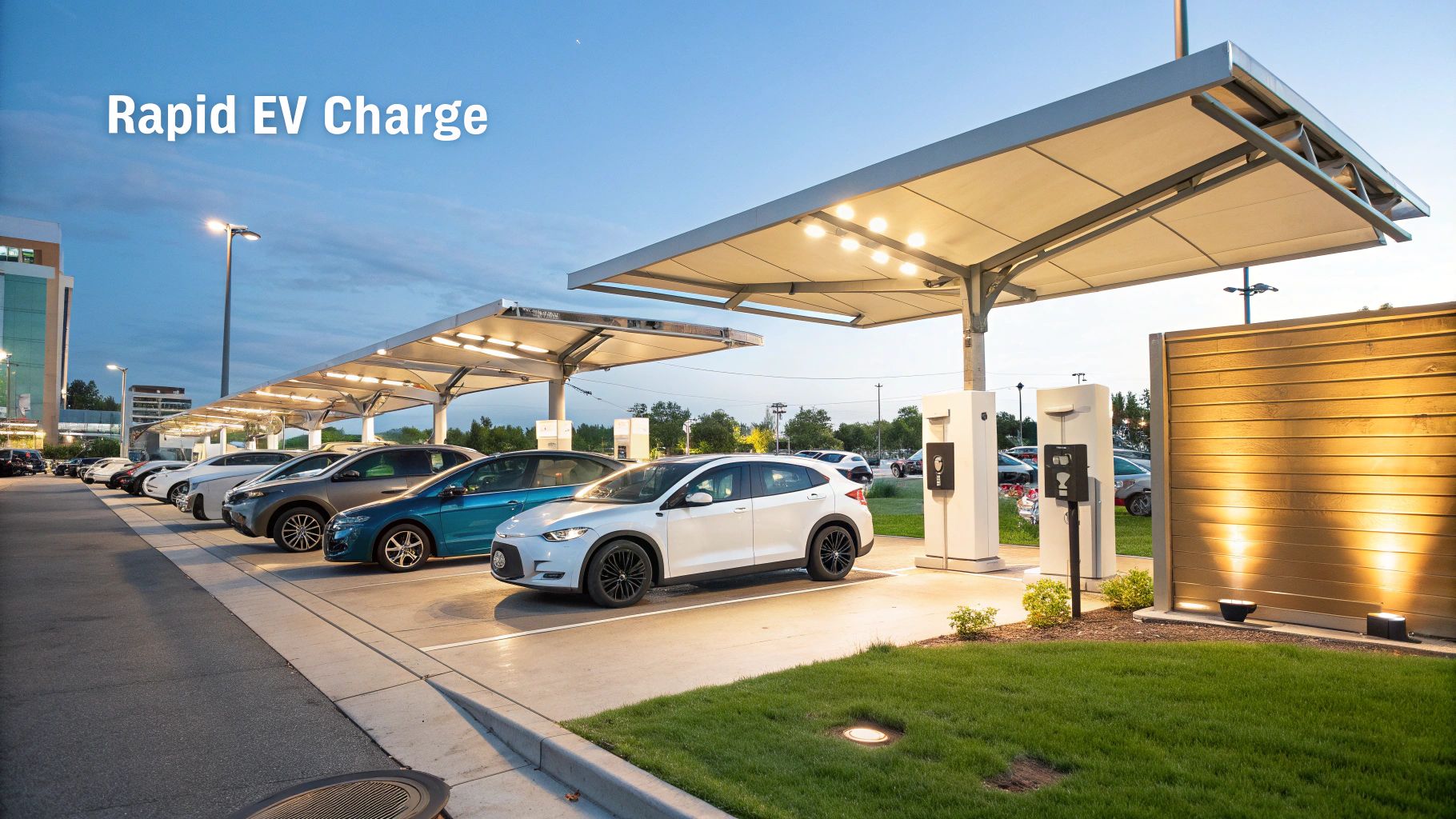
One of the UK’s most pressing energy puzzles is how to roll out powerful, rapid EV charging hubs when the local grid infrastructure simply cannot handle the load. Many ideal spots for charging stations—think motorway services or retail parks—are served by grid connections that were never designed for the massive power draws needed by a fleet of modern electric vehicles.
This is a major roadblock. Upgrading the grid is an incredibly slow and expensive process, often bogged down by years of planning and eye-watering investment. For businesses eager to meet the soaring demand for EV charging, this delay is a serious commercial headache.
Luckily, storage battery systems offer a clever and effective workaround. They act as a crucial buffer, completely changing the dynamic between the charging station and the grid.
Using Peak Shaving to Power Rapid Charging
Picture a large water butt slowly collecting rainwater overnight. Then, when it is time to water the garden, you can open the tap and release a powerful flow in just a few minutes. A battery-backed EV charging system works on exactly the same principle.
The system ‘trickle-charges’ its batteries from a low-power grid connection during off-peak times, like overnight when electricity is cheaper and local demand is minimal. It steadily gathers energy over several hours, storing it up for the busy day ahead.
Then, during peak times, when multiple EVs pull in for a rapid charge, the system unleashes this stored energy in a massive, controlled surge. This process is known as peak shaving .
By storing energy in advance, the system avoids yanking huge amounts of power directly from the grid all at once. It effectively 'shaves off' the extreme peaks in demand, letting high-power charging operate perfectly well on a low-power grid connection.
This approach makes rapid charging viable without needing to dig up roads for costly grid reinforcements. Businesses can deploy charging hubs much faster and at a fraction of the cost, accelerating the UK's switch to electric mobility.
The growth in this technology could not be more timely. The first half of 2025 saw a dramatic surge in UK battery energy storage system activity, with project completions jumping 78% year-on-year. This reflects the sector's vital role, as planning approvals for new projects also shot up by 49% , signalling strong investor confidence in solutions that support Britain’s clean power goals.
Flexible Power with Mobile EV Charging
The flexibility of storage battery systems goes well beyond fixed installations. A brilliant innovation gaining traction is the rise of mobile EV charging units—essentially, powerful batteries on wheels. These mobile systems provide on-demand rapid charging wherever it is needed most, completely untethered from a permanent grid connection.
This technology opens up a whole range of new possibilities:
- Fleet Depots: Provides temporary charging capacity for electric fleets without forcing immediate, expensive depot upgrades.
- Events and Festivals: Delivers rapid charging for attendees at temporary venues where grid access is limited or non-existent.
- Roadside Assistance: Offers a vital power boost for EV drivers who have run out of charge on the road.
These mobile units are a perfect demonstration of the adaptability of battery storage. They can be deployed quickly to fill charging gaps, support specific operational needs or even test demand in new locations before you commit to a permanent installation. By providing power where and when it is needed, mobile EV charging is another way battery tech is making the electric vehicle revolution more practical and accessible across the country.
Integrating Renewables with Grid Scale Batteries
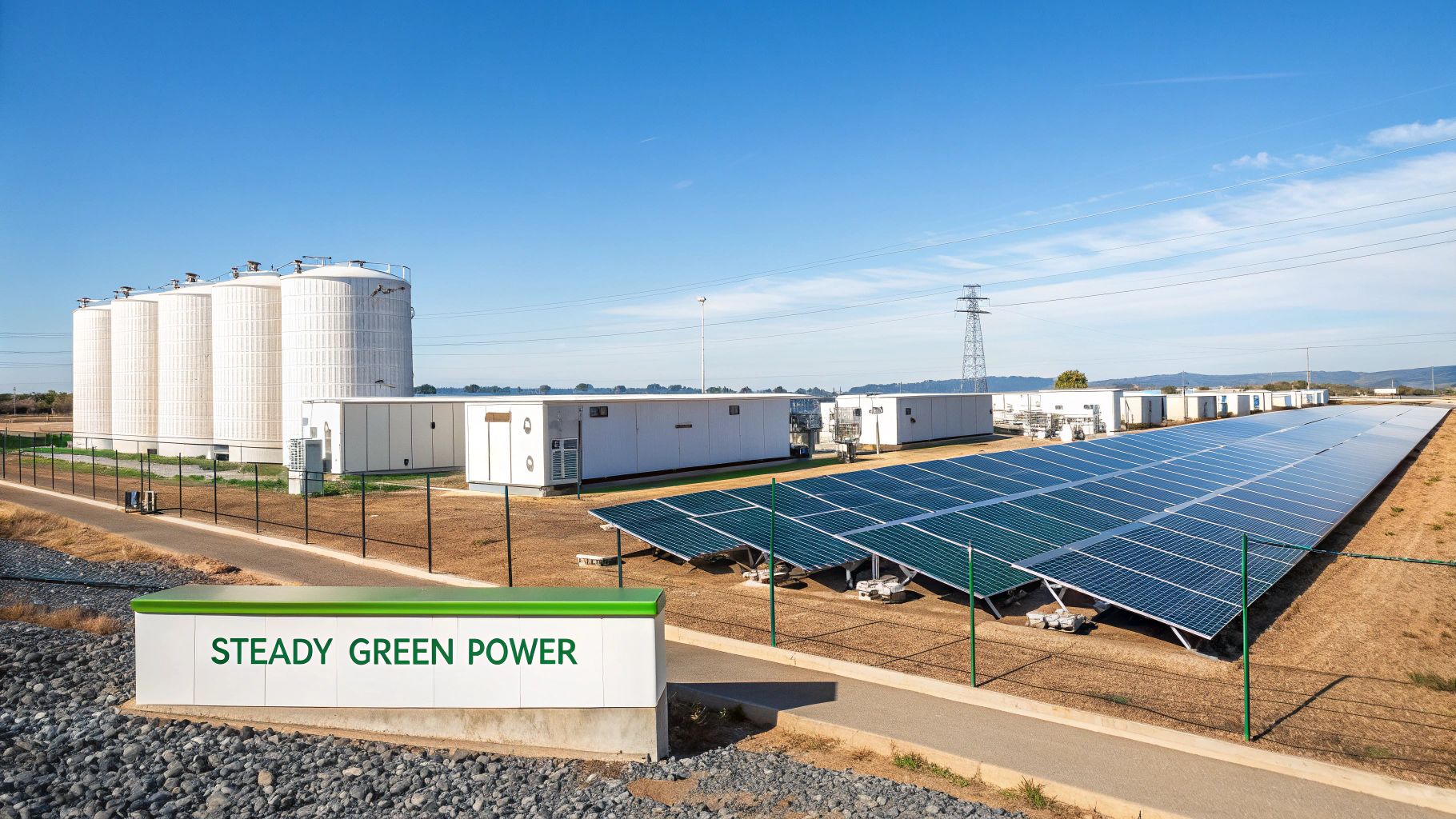
While battery storage is a game-changer for local EV charging, its biggest impact is happening at a national level. Let’s zoom out to the wider energy landscape, where the powerful partnership between huge renewable projects and grid scale batteries is reshaping the UK’s entire power supply.
Renewable energy sources like wind and solar are the cornerstones of our net-zero strategy but they come with a well-known problem: you cannot control when they generate power. The wind does not always blow and the sun does not always shine right when we need it most. This mismatch between generation and demand has always been a major hurdle, making it tough to rely completely on clean energy.
This is where large-scale storage battery systems step in. Think of them as enormous energy reservoirs that capture unpredictable renewable power and turn it into a firm, reliable source we can count on.
A Day in the Life of a Grid Scale Battery
To really get a feel for their role, let’s walk through a typical 24-hour cycle for a grid-scale battery hooked up to a wind farm.
-
Dead of Night (1 AM - 4 AM): National electricity demand is at its lowest but strong overnight winds mean the turbines are spinning at full tilt. Instead of being wasted, all this surplus green energy is absorbed by the battery, charging it up for the day ahead.
-
Morning Rush (7 AM - 9 AM): The country wakes up and demand for electricity suddenly surges. The wind might have died down but the fully charged battery instantly starts to discharge, releasing its stored clean power to help stabilise the grid and meet the morning peak.
-
Afternoon Lull (2 PM - 4 PM): Demand eases off. Maybe the sun is out and solar farms are now generating more power than is needed. The battery can switch back to charging mode, soaking up this excess solar energy.
-
Evening Peak (5 PM - 7 PM): The evening demand spike hits as people get home from work. The battery once again discharges, providing a critical burst of power to keep the grid balanced and reduce the need for expensive, fossil-fuel 'peaker' plants.
This constant cycle of charging and discharging—absorbing energy when it is plentiful and releasing it when it is scarce—is what turns intermittent renewables into a dispatchable asset. Grid operators can now call upon clean energy on demand, just as they would with a traditional power station.
The Power of Co-location
This synergy is being pushed even further through a strategy called co-location , where massive storage battery systems are built right next to wind or solar farms. The result is a single, integrated clean power plant.
This model is incredibly efficient. It minimises energy losses by storing electricity at the point of generation and makes connecting to the national grid far simpler. For developers, it transforms their project from an unpredictable generator into a dependable power source that can play a much bigger role in energy markets.
The UK has clearly recognised just how critical this technology is. Since 2020 operational battery storage capacity has exploded from 1,128 MW to a projected 6,872 MW in 2025. That’s a phenomenal increase of over 509% . This rapid expansion is essential for smoothing out supply and shows the huge investment being made in grid scale batteries to support our clean energy goals. You can find out more about the UK's leading position in adopting large-scale battery storage on blackridgeresearch.com.
Of course, storage batteries are impressive bits of kit from a technical standpoint. But what really gets investors excited is the powerful commercial case behind them. While they are crucial for bringing more renewables online and supporting the EV rollout, they are also hard-working commercial assets that can generate serious revenue. How? By playing a smart game in Great Britain’s sophisticated energy markets.
Think of these systems less as passive containers of energy and more as active financial instruments. Operators use them to tap into complex market mechanisms, effectively turning grid instability and volatile wholesale prices into profit. This strong business case is what’s really accelerating investment in clean technology across the UK.
Generating Revenue from Grid Stability
A big chunk of a battery's income comes from providing what are known as grid balancing services. The National Grid has the immense task of perfectly matching electricity supply with demand, second by second, every single day. It pays handsomely for assets that can help maintain this delicate equilibrium. This is where the sheer speed of a battery system becomes its killer commercial advantage.
Operators can participate in markets like the Balancing Mechanism . Here they get paid to either soak up excess power from the grid when there is a surplus or instantly inject power to cover a shortfall. Because batteries can flip from charging to discharging in milliseconds, they are perfectly built for these rapid-response services, making them one of the most effective and valuable tools for keeping the lights on.
The Art of Energy Arbitrage
The simplest way to picture how a battery makes money is through energy arbitrage . It is the classic "buy low, sell high" strategy, applied to electricity.
- Buying Low: Operators charge their batteries when wholesale electricity is cheapest, usually overnight when demand is low.
- Selling High: They then discharge this stored energy back to the grid during peak times, like the early evening rush when everyone gets home and puts the kettle on, and prices are at their highest.
The profit is found in that price difference or the 'spread'. The more energy prices swing up and down, the more profitable arbitrage becomes.
A fascinating and increasingly common opportunity comes from 'negative pricing' events. When renewable generation—especially from wind farms—is incredibly high but demand is low, the grid can get overloaded. At these moments, battery operators are literally paid to take this excess energy off the grid. They turn a major grid headache into a direct revenue stream.
This is not just theory, either. The numbers prove it. In June 2025 battery storage systems in Great Britain earned an average of £76,000 per megawatt per year —a 20% jump from the previous month. This was driven by 66 hours of negative pricing thanks to high winds and a 35% increase in intraday price spreads during a heatwave.
Well over half of this revenue came directly from wholesale trading and the Balancing Mechanism, proving the real-world economic viability of these systems. You can explore more on the UK's battery storage revenue benchmarks to see the data for yourself. It all goes to show that storage battery systems are not just an environmental nice-to-have; they are a smart, profitable investment.
The Dawn of the UK’s Smart and Distributed Grid
All the pieces we have talked about—from supercharging EVs to weaving in renewables—are coming together to build something much bigger. We are witnessing a fundamental shift in how the UK’s energy system actually works. For the last century we have relied on a centralised grid where a few giant power plants push electricity outwards to the rest of the country. That old model is finally making way for a smarter, more resilient alternative.
We are moving towards what is known as a distributed energy model or a ‘smart grid’. This is not just a single network; it is an intelligent web connecting thousands of different assets, all working in harmony. Just imagine a future where commercial batteries, EV charging hubs, mobile units and rooftop solar panels are all talking to each other and cooperating.
Building an Intelligent and Resilient Network
In this new ecosystem storage battery systems are the foundational technology holding it all together. They are the crucial link, operating at every level of the grid, from individual business sites all the way up to the national transmission network. This distributed approach unlocks enormous benefits, creating a grid that is far more efficient, cost-effective and reliable.
Think of it like the difference between an old-school mainframe computer and the modern internet. A centralised system has single points of failure that can bring everything crashing down. A distributed network, on the other hand, can simply reroute power, absorb shocks and adapt to changing conditions in real time.
This transition represents a move from a rigid, top-down structure to a flexible, dynamic and intelligent network. By decentralising energy resources, we create a system that is inherently more robust and can better manage the challenges of intermittent renewables and high-demand EV charging.
The Linchpin of a Modern Energy System
This distributed model is not some far-off dream; it is being built right now, piece by piece. Every new battery-backed EV charger, every grid-scale battery project and every business pairing solar with storage adds another intelligent node to this expanding network. Together these assets create a system that can shave demand peaks, fill supply troughs and maintain a perfect balance across the grid.
The result is a twenty-first-century energy system that is cleaner, smarter and far more secure. You can explore more about how ZPN is contributing to the green grid and a more connected world . Ultimately, storage battery systems are the linchpin holding this entire vision together, cementing their status as the most critical asset in the UK's journey towards a sustainable and electrified future.
We Answer Your Burning Questions
This section tackles the most common questions we hear about storage battery systems here in the UK. We will give you clear, straight-up answers to help you get a solid grasp of their role in EV charging, grid stability and renewable energy.
What Is the Main Purpose of a Storage Battery System?
At its heart, a storage battery system is all about balancing electricity supply and demand. They are designed to soak up energy when it is plentiful and cheap—think of a wind farm on a gusty night—and then feed it back to the grid when demand spikes and power is more expensive.
This function is absolutely vital for making intermittent renewables a reliable part of our energy mix and for supporting power-hungry applications like rapid EV charging . It is like an energy reservoir, ensuring clean power is not wasted and is ready to go when we need it most. That simple act makes the entire grid more efficient.
By acting as this critical buffer, battery systems turn unpredictable energy sources into a dependable, dispatchable asset. This capability is essential for building a modern, decarbonised energy network.
How Do Batteries Help with EV Charging from Constrained Grids?
This is a big one. A lot of places that are perfect for EV charging hubs—think retail parks or motorway services—have surprisingly weak grid connections. They simply cannot handle the massive power draw needed for multiple rapid chargers firing up at once.
A battery system neatly solves this problem by acting as a middleman. It sips power from the grid, trickle-charging slowly during off-peak hours to fill itself up.
Then, when a stream of EVs plug in, the battery discharges all that stored energy in a powerful surge, completely bypassing the grid's limitations. This technique, known as peak shaving, makes rapid EV charging possible without waiting for slow and eye-wateringly expensive grid upgrades. It gets charging infrastructure on the ground faster and more cost-effectively.
Can a Business with On-Site Renewables Use a Battery?
Absolutely and it is one of the smartest energy moves a business can make. Pairing on-site renewables like solar panels with a battery is a game-changer. The battery stores any surplus solar energy generated during the day that you are not using, which would otherwise be sold back to the grid for pennies.
You can then use that stored clean energy during the evening or on cloudy days, drastically cutting your reliance on the grid and slashing your energy bills. It maximises the return on your renewables investment and gives you a reliable backup power source to boot.
For those interested in the principles of battery longevity across different uses, this guide on maximizing electric bike battery life offers some great foundational knowledge.
At ZPN Energy , we specialise in delivering advanced storage battery systems and rapid EV charging solutions that empower businesses and grid operators across the UK. Discover how our technology can support your energy goals by visiting https://www.zpnenergy.com.


